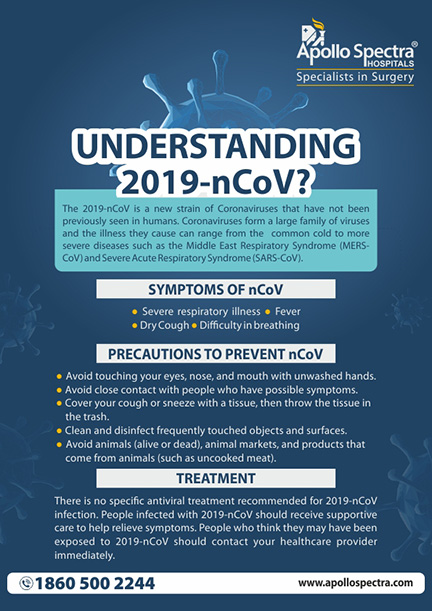Coronavirus
January 31, 2020
Coronavirus has been reported to kill more than 130 people in China and infected thousands across the world. Governments all over the world have been trying to pre-empt the spread of the virus called 2019 novel coronavirus (2019-nCoV). The World Health Organization (WHO) has declared the coronavirus epidemic as a high global risk. However, it is still not declared as a Public Health Emergency of International Concern (PHEIC).

What is Coronavirus?
Coronavirus is a part of a group of viruses that are responsible for respiratory illnesses like the common cold. Most people are infected with the virus at some point in their life. However, the symptoms remain mild to moderate. In some cases, the virus can result in lower-respiratory tract illnesses like bronchitis and pneumonia. This virus is very common among animals, but it affects only a handful of humans. The coronavirus epidemic that we are facing is because of the evolved form of the virus called the Severe Acute Respiratory Syndrome Coronavirus (SARS-Cov) and the Middle East Respiratory Coronavirus (MERS-CoV). Both of these display severe symptoms.
Symptoms
The symptoms of coronavirus are similar to most upper respiratory infections like coughing, sore throat, runny nose, and fever. Distinguishing the symptoms of a cold-causing virus like rhinovirus and coronavirus is extremely difficult. Only through lab tests, will we be able to know if the cold is caused by the coronavirus or not. This includes blood work, nose, and throat cultures. However, the test results do not have any effect on how the symptoms will be treated.
As long as the coronavirus is in the upper respiratory tract, the symptoms will go away in a few days. However, if it starts spreading to the lower respiratory tract like your lungs and the windpipe, it can result in pneumonia. People with heart disease and a weakened immune system are more vulnerable.
Treatment
Currently, there are no specific treatments available to treat human coronavirus. Most of the people infected with the virus will recover on their own. However, there are a few things that can be done for relieving the symptoms:
- Take fever and pain medications. Children should not be given Aspirin.
- Take a hot shower or use a room humidifier or steam inhalation for helping ease cough or a sore throat.
- If you are feeling sick, you should drink lots of liquids and stay at home and rest.
If you think your symptoms are worsening, contact a doctor immediately.
Prevention
Unfortunately, there are no vaccinations available for protecting yourself against the human coronavirus infection. However, you can still reduce the risk of getting infected by doing the following:
- Wash your hands frequently with soap and water for more than 20 seconds.
- Avoid getting in close contact with sick people
- Wash your hands before touching your eyes, mouth or nose
- If you have symptoms resembling cold, you can protect others by staying home, avoiding close contact, cleaning and disinfecting surfaces and objects. Also, when you are coughing or sneezing, you should cover your nose and mouth with a tissue. After this, throw the tissue in the garbage and wash your hands.
Transmission of the virus
This new coronavirus can be transmitted from animals to humans. It is also capable of mutating and adapting which is helping the virus spread faster. It has also made the virus more difficult to treat. The authorities are still not sure exactly how infectious the coronavirus is. Most forms of coronaviruses are transmitted by sneezing and coughing. The first infection was noted in Wuhan and is traced back to an animal and fish market. The market has now been shut down. It is possible that the virus was transmitted through the air like other germs or through direct contact between the animals and the humans.
Stopping the outbreak
According to The New York Times, the Chinese government has stopped travel to and from Wuhan and 12 nearby cities. This lockdown is affecting about 35 million people. Also, the Taiwan government announced that it will not be allowing anyone in from the Hubei Province. The Hong Kong government declared that it will be barring anyone who is a resident of the Hubei Province or had visited the place in the past 14 days. The Chinese government has also banned the sale of wildlife temporarily in restaurants, markets, and e-commerce. This will definitely help in ending the possibility of the outbreak of a worldwide epidemic.
Almost all the airports in the USA have been conducting screenings for trying to look for symptoms of the coronavirus. However, evidence shows that the virus can spread even before a person displays the symptoms. According to US officials, they are reevaluating whether screening is effective or not. Also, they might be considering broadening the screenings at airports. They will be updating their travel recommendations for American citizens. The CDC has recommended avoiding non-essential travel to Wuhan. On 23rd January 2020, the US State Department ordered all the non-emergency US families and personnel to leave Wuhan.
Airports in China and all around the world are performing fever checks for people traveling from China. In case the outbreak is declared as an international public health emergency, international travel might be restricted. Governments will have tighter border checks. Special treatment centers and quarantine areas will be set up. All the people are advised to maintain good hygiene and practice caution. For example, you need to avoid contacting a person with an acute respiratory infection. Also, it is best to stay away from livestock or wild animals, dead or alive. Wash your hands regularly, especially if you have been in direct contact with an infected person. WHO hasn’t yet issued a travel warning for Wuhan. Health experts believe that the new coronavirus won’t be spreading globally.
Spreading of the virus
The first case of pneumonia-like symptoms was reported on 31st December 2019, in Wuhan. Since then, the virus has spread to other countries like Japan, Thailand, the Republic of Korea, Australia, the United States, Taiwan, France, etc. On 25th January, a presumptive case of the coronavirus was reported in Toronto. A 50-year old man who had visited Wuhan was showing the symptoms of the disease. At the same time, a patient in Lisbon was displaying the symptoms of the virus as well. This person had also traveled to Wuhan recently.
On January 21st, the first case was confirmed in the US where a man in the Washington state was displaying the symptoms. He had recently visited Wuhan. A second case was confirmed on January 24 in a woman from Chicago who had visited the Chinese city recently. Both of them were hospitalized. However, their conditions weren’t severe. Since then, there have been 5 confirmed cases of coronavirus in the United States. The US agency, the Centers for Disease Control and Prevention, is currently investigating about 110 people from 26 states who might be possibly infected with the virus.
Virus Hopping from Animals to Humans
Coronavirus is one of the few viruses that can be transmitted from animals to humans. In the Journal of Medical Virology, a study was published that revealed how the virus was transmitted. According to the study, this was likely the snake host. The researchers found that a change to one of the viral proteins of the coronavirus gives them the ability of recognizing and binding to receptors on certain host cells. This ability is essential for entering cells. This change in the protein is what allows the virus to hop into humans. Now, even though the primary transmission mode is from animal to humans, people can catch the coronavirus from other humans. The most common ways the virus can spread from an infected person to others include:
- Air (viral particles from a sneeze or a cough)
- Close personal contact (shaking or touching hands)
- Surface or object with viral particles on it (when you touch your eyes, nose or mouth before washing your hands)
- In very rare cases, through fecal contamination
Virus becoming a pandemic
For any virus to become a pandemic in humans, it must be able to do the following three things:
- Infect humans efficiently
- Replicate in humans
- Spread among humans easily
According to the CDC, the virus is passing among humans in a limited manner. They are still investigating. However, currently, there have been no cases registered of human-to-human transmission in the US. Also, since the risk of infection in an individual depends on the exposure and there has been a low number of confirmed coronavirus cases in the US, CDC has declared the risk of infection low at this time in the country.
India’s response
Looking at the previous cases of MERS and SARS, it is possible that the virus will spread from close contact between humans. So, in the coming days, more cases will be identified. With MERS and SARS, where the coronaviruses were able to jump the species barrier, people had to suffer through a severe illness. Also, the person-to-person spread was seen. Even the healthcare workers who were taking care of the ill patients got infected.
The Health Ministry of India has been trying to take control of the situation before it affects the country. Since the virus was first identified, about 9150 passengers have been tested for the coronavirus. Till now, there have been no confirmed cases of novel coronavirus in India. The Health Ministry has asked people traveling from China to visit their nearest medical center if they are not feeling well. Also, the authorities at the airports of Delhi, Mumbai, Bengaluru, Hyderabad, Chennai, Kolkata, and Chennai have been asked to screen people traveling from China.
NOTICE BOARD
CONTACT US
CONTACT US
 Book Appointment
Book Appointment


.svg)
.svg)
.svg)
.svg)








